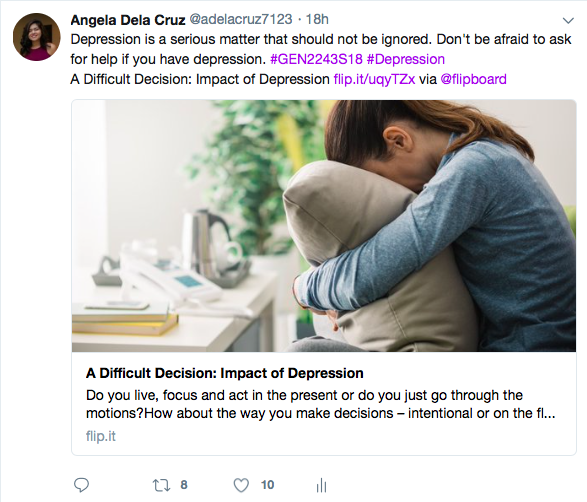Learning New Applications
By: Angela Dela Cruz
Through advanced technology, people are able to create apps with new features that have never been done before. In class we examined apps that incorporate augmented reality as well as virtual reality. Augmented reality integrates digital elements to a live view, mixing real world with the digital world, whereas digital reality provides a full immersion experience without the user's current surroundings. An example of an app with augmented reality is Anatomy 4D, which had templates that users print out and scan with their device to see a 4D model of the body. It is extremely helpful for those in the health field as it provides a more dimensional view instead of just looking at a flat image, and people can also choose to view specific body systems, such as the lymphatic, nervous, integumentary, and more.
For those studying chemistry, the Elements 4D app is similar to the previous app but instead allows people to see what the elements look like, their names, and their atomic weight. It also lets individuals combine two elements and see how they react, including the catalyst, resulting compound, and chemical equation. Zookazam is another app that does not require a printed marker, but permits users to see a three dimensional view of animals simply by scanning a background provided by the app, or by scanning a one dollar bill. These apps are not only entertaining and interactive but help people visualize what might be hard to picture.
In an article by Mariella Moon, she talks about how the store Target takes advantage of augmented reality and has incorporated it into its application. There is a new feature called "See it in your space" which lets people see what a piece of furniture looks like in a room, helpful to those who shop online from home. This is a good marketing plan as it helps encourage buyers since they are able to visualize the final set up, reducing their stress if they are worried that the furniture might be too big or might not match the room.
Augmented reality is also something used for scientific purposes, such as how archeologist Stuart Eve is using it to help people visualize past structures. An article by Carl Engelking shows that Stuart Eve is developing a mobile app that allows people to look through their screen and see reconstructions of ancient houses. He was not just able to see the huts of an ancient village, but could walk inside to see the view from the front door. The article further states that augmented reality is already a part of our lives, as people can venture through cities and see geo-targeted stories at certain landmarks.
Even airports are starting to use augmented reality, and one article states that Singapore's Changi airport has given smart glasses to their ground crew that gives instructions to them. With the glasses a ground handler is able to scan a virtual QR code on the baggage or cargo, giving handlers details of the weight, loading sequence, and position within the aircraft. There are also cameras on the glasses that allows the control staff to monitor the handlers and cargo, showing how the glasses improve efficiency by cutting loading times by 15 minutes, shortening waiting times for passengers.
The apps we experimented with that incorporated virtual reality were Google Cardboard and Discovery VR. With Google cardboard, people use a cardboard viewer that they can buy or build themselves, and then place their smartphone in that viewer to immerse in virtual reality videos. Discovery VR is similar and includes shows such as Shark Week and Myth Busters, thrill seeking videos such as sky diving, and videos of nature such as swimming with elephants. The videos also give watchers a 360 degree perspective of whatever they're observing, making it seem like the people viewing are actually at the destination. With virtual reality, users completely immerse themselves in the videos provided by the app.

In addition to learning new apps, I also discovered an app related to my health science major for the App Smackdown assignment. The app I discovered is Cronometer, and it helps individuals track what they eat. The app is extremely helpful because it not only tracks the calories of the foods people eat, but even the macronutrients such as the amount of protein, fats, and carbohydrates, as well as the vitamins and proteins in each food. The app contains a scanner so that people can scan barcodes if a certain item shows no nutritional information, and there are restaurants and brands that the app recognizes such as the school store Au Bon Pain. Users are able to input their physical activity to get a better estimation of the calories they burn versus the calories they eat. Applications are not only for entertainment but help people organize their daily tasks.

In addition to learning about new applications, I also read chapter four of Untangling the Web. The chapter states that social media is not just a source of information but also helps people connect for educational purposes. One of the examples given is the program Skype, which is one of the earliest video chatting programs. With Skype, video conferencing is possible and people that are hundreds of miles apart may talk to each other, creating a better learning experience as a classroom from the United States can talk to another classroom from Asia, letting both learn about each others cultures. Edmomo is another program but is one of the first social networks specifically made for schools. It provides an online class community where teachers can post notes, assignments, quizzes, alerts, and polls. Teachers are able to broadcast messages to specific subgroups or an entire class, making it easier for students just in case of events such as snow days. With the new and advanced programs, children are ensured to get all the information they need.





Comments
Post a Comment